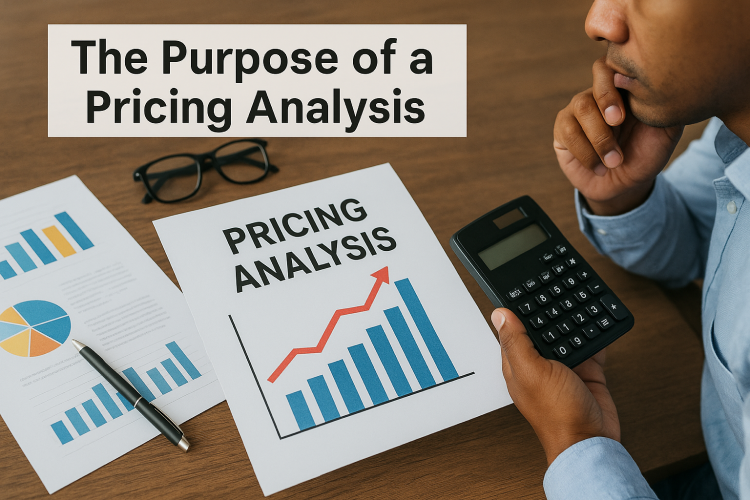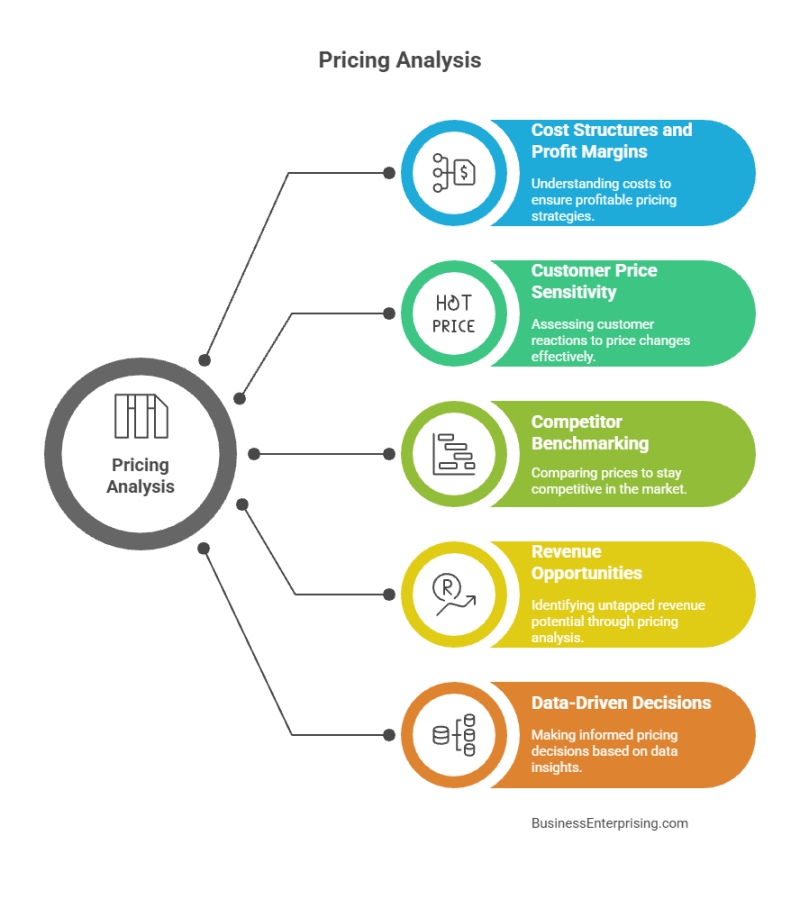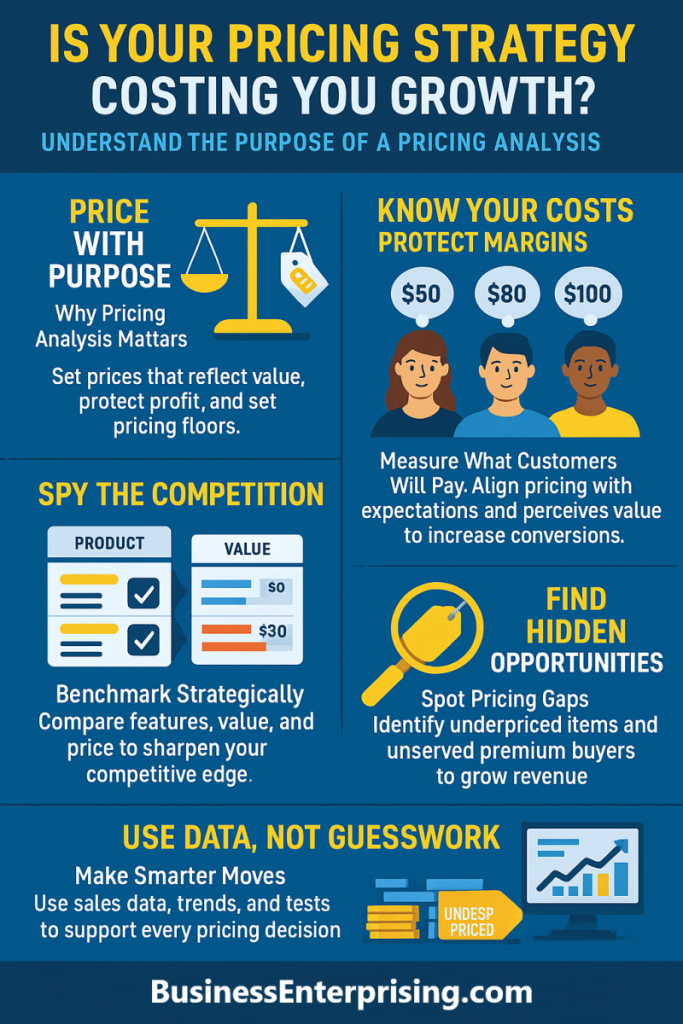
Additionally, pricing affects how people view your brand. A price that feels too low might signal poor quality. However, one that feels too high could drive buyers away. That’s why your pricing strategy should reflect both internal numbers and external demand. When your price matches your value, customers respond more positively.
Many businesses make the mistake of setting prices once and leaving them unchanged. Over time, that approach can limit growth or create risk. Therefore, reviewing your pricing regularly helps you stay flexible. You’ll catch trends early, correct mistakes, and find opportunities that others miss.
Pricing analysis does not need to be complicated. You can start with basic data like sales volume, profit margins, and competitor benchmarks. From there, you can test small changes and track results. Additionally, you’ll begin to see patterns that help guide future decisions. A thoughtful pricing strategy gives you more than higher revenue. It gives you control. You’ll stop reacting and start planning. That’s how smart businesses stay competitive in any market.
Defining Pricing Analysis and Its Role in Strategy
Pricing analysis helps you understand how your pricing affects revenue, profit, and competitiveness. It looks at costs, customer behavior, and market conditions. The purpose of a pricing analysis is to find the most effective price point for each product or service. That price needs to balance profit goals with what customers are willing to pay.
You can use this analysis to shape your broader strategy. For example, if you discover that one product line supports most of your profit, you may shift focus there. Additionally, pricing analysis helps you compare your current rates to competitors. That comparison can reveal if your offer is underpriced, overpriced, or in line with expectations.
Revenue planning also benefits from strong pricing insights. When you know your profit margins and sales volume, you can forecast with more accuracy. Therefore, this analysis supports smarter financial planning and more confident decision-making.
Positioning is another key outcome. Your pricing sends a message about the value of your product. If you want to compete on quality, your price needs to reflect that. However, if your goal is volume, lower pricing with tighter margins might work better. Therefore, the results of your pricing analysis help define how your brand is viewed in the market.
Without this level of insight, it’s easy to rely on guesswork or outdated benchmarks. That approach can limit growth or erode profits over time. By making pricing analysis a regular part of your business review, you build a stronger foundation for long-term success.
Understanding Cost Structures and Profit Margins
To price your product effectively, you need to understand your cost structure. Every business carries both fixed and variable costs. Fixed costs include rent, salaries, and software. These don’t change when sales go up or down. Variable costs rise or fall depending on how much you produce or sell. These often include materials, packaging, and shipping.
The purpose of a pricing analysis is to make sure your prices cover all of those costs while still leaving room for profit. Therefore, you must know your break-even point. That is the point where revenue equals total costs. Pricing below that point leads to a loss, even if your sales volume looks strong.
Additionally, knowing your cost structure helps you set a pricing floor. This is the lowest price you can offer without taking a hit. Many businesses ignore this and focus only on market rates. However, that can erode your margin and create long-term risk. If your margins get too tight, you’ll struggle to reinvest or scale operations.
Analyzing your profit margins gives you insight into product performance. Some products may sell well but generate little profit. Others may have higher margins but move slower. Therefore, you need both sets of data to decide which items deserve more attention. You can’t rely on guesswork when it comes to pricing. A clear view of your costs gives you more control. That control allows you to adjust pricing, bundle offers, or cut expenses without harming your profitability.
Evaluating Customer Price Sensitivity and Perceived Value
Price sensitivity tells you how much a customer’s buying decision changes when you raise or lower the price. Some customers will walk away over a small increase. Others will pay more if they believe the value matches the cost. Therefore, understanding these differences helps you avoid losing sales or underpricing your offer.
The purpose of a pricing analysis includes learning how your customers react to price changes. It also helps you test what value they expect at different price levels. For example, buyers may tolerate higher prices if the product solves a key problem. However, they may resist if they think it offers no clear advantage over cheaper options.
Additionally, customer expectations vary by segment. Some people value speed or design, while others focus on durability or savings. Therefore, knowing what your customers value most can guide your pricing decisions. A price that seems high can still succeed if it reflects quality, status, or convenience.
Perceived value plays a large role in loyalty. When customers believe they got a fair deal, they come back. That loyalty improves retention and reduces your marketing costs over time. However, if customers feel overcharged or misled, they often stop buying and tell others.
Evaluating price sensitivity and perceived value is not guesswork. You can gather data through feedback, testing, and sales history. The more you learn, the more effectively you can fine-tune your pricing strategy. That insight helps you keep your margins strong while building long-term relationships with your best customers.
Benchmarking Against Competitors
Knowing how your competitors price similar products helps you make smarter pricing decisions. Benchmarking gives you a direct view of market expectations. It also shows how your offer compares in terms of features, benefits, and brand strength. Therefore, it helps you find out if you’re charging too much or leaving money on the table.
The purpose of a pricing analysis includes identifying where you fit in the market. If your product costs more than others, your value must be clear. However, if you charge less and still offer more features, you might gain volume but lose margin. Comparing prices, positioning, and quality helps you strike a better balance.
Additionally, competitor pricing reveals patterns and signals. For example, you may notice seasonal price drops or frequent promotions. That information can help you prepare ahead of time and avoid reactive discounting. Therefore, staying aware of pricing trends can protect your revenue and brand position.
Price alone is not the full picture. Customers also judge perceived value, packaging, service, and delivery. Therefore, your comparison should include the full offer. If you find a gap in your value proposition, consider whether pricing or positioning needs to change.
A regular review of competitor pricing keeps your strategy aligned with the market. You don’t need to copy others, but you do need to understand them. That insight helps you adjust with purpose rather than guesswork, keeping your pricing competitive and strategic.
Identifying Revenue Opportunities and Pricing Gaps
Every business has hidden pricing opportunities. You may be undercharging for a product with high value or overlooking a premium option. These gaps can limit revenue and send the wrong message to your market. The purpose of a pricing analysis is to uncover those opportunities before they turn into missed income.
Additionally, pricing gaps may show up when you compare products within your own catalog. A lower-priced product might offer more value than a higher-priced one. That signals a need to adjust either pricing or features. Therefore, internal comparisons are as important as external ones when reviewing your pricing strategy.
You might also find unserved market segments. For example, your current prices may serve only the mid-range buyer. However, a higher-tier customer may be willing to pay more for added service or exclusivity. If you don’t offer that tier, someone else will. That makes room for new products, bundles, or service plans that reflect higher value.
Small adjustments can also lead to big results. You may discover that a slight price increase improves margins with little impact on demand. Therefore, testing prices regularly gives you a more accurate view of customer behavior. It also helps you avoid leaving revenue on the table.
Every dollar gained from smarter pricing flows straight to your bottom line. When you review your prices with intention, you open doors to long-term growth. That’s why consistent pricing analysis plays such an important role in your revenue strategy.
Supporting Data-Driven Pricing Decisions
Relying on instinct to set prices can lead to missed goals and lost revenue. Data removes the guesswork and supports better decisions. Therefore, using sales history, conversion rates, and competitor trends helps you make more confident moves. You see what worked, what didn’t, and where to adjust.
The purpose of a pricing analysis is to guide your strategy using real numbers, not assumptions. Your sales data shows how customers respond at each price point. Additionally, tracking discount impact helps you see if lower prices truly drive volume or just lower margin. That information becomes the basis for smarter adjustments.
Historical data reveals patterns that can’t be ignored. You may notice that prices perform better during certain months or after key events. Therefore, seasonality and timing should factor into your pricing strategy. That gives you a better chance to match customer expectations and maximize revenue.
Market data also matters. Industry reports and competitor movement help you stay relevant. However, your internal metrics carry more weight for day-to-day decisions. Pairing those with market trends keeps your pricing both competitive and grounded in your business reality.
Additionally, you can test price changes in small segments before applying them across your catalog. That approach lowers risk and builds clarity. Pricing becomes more than a guess. It becomes a process supported by results. When you follow the data, you gain control over your pricing and its impact on performance.
Conclusion
Pricing affects every part of your business, from daily operations to long-term growth. You need more than intuition to get it right. The purpose of a pricing analysis is to give structure to those decisions using facts, not assumptions. That structure leads to better outcomes and fewer surprises.
Additionally, pricing analysis helps you stay competitive without racing to the bottom. You can spot underused opportunities and remove low-margin risks. As a result, your pricing begins to reflect both customer expectations and business realities. That alignment helps you stay consistent and make quicker adjustments when needed.
However, pricing is never a one-time exercise. Markets shift, customer behavior changes, and cost structures evolve. Therefore, making pricing analysis a regular habit helps you keep up. It becomes easier to adjust without starting over. That consistency builds confidence in your decisions and helps you stay ahead of challenges.
You don’t need perfect data to begin. Start with what you already have and build from there. Additionally, take time to ask questions about your best and worst performers. The answers will often point toward smarter pricing moves.
Each change you make through analysis adds up. Over time, these small adjustments improve your revenue, profit, and customer retention. When pricing aligns with value and data, it becomes a tool—not a guess. That’s how pricing supports growth you can depend on.



